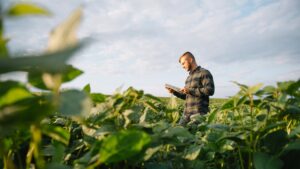In the past few decades, crop protection tools’ impact on the environment have decreased steadily even as yields have dramatically increased. Innovative inputs, new ways to farm and more precise application technologies mean we as a company and we as the entire agriculture industry have the opportunity – and the responsibility – to constantly improve how we interact with our environment.
At Bayer, we’re proud to help growers produce more with less. According to an assessment conducted by the Technical University of Denmark, the environmental impact of Bayer’s crop protection portfolio versus its total acres is exceptionally low, both in total impact and when compared to other companies. Though we’re proud of that achievement, we believe more can be done. In fact, we’re committed to further impact reductions by 2030. Specifically, we plan to reduce the environmental impact of our crop protection tools on a global treated area per hectare basis by 30% by 2030 compared to a 2014-2018 average baseline.
How will we achieve this change? Because there is no one-size-fits-all solution in farming, we will partner with growers in a variety of ways that best suit their specific geographic and cropping realities. Some of the tools we’ll use to optimize crop protection include: precision application tools to ensure the right amount of product is applied at the right time and in the right place, seed applied treatments to reduce the volume of product used, and targeted genetics and traits that reduce the need for in-field chemical crop protection. We’re also striving to develop new chemistries that offer both efficacy and reduced environmental risk, and new biologics that complement and enhance integrated pest management. And we’re working with growers to help them learn holistic best management practices like buffer strips, tillage practices, cover crops and drift / run-off mitigation techniques that support improved stewardship and integrated pest management.
It’s not enough to say we’re improving; we need to show real change. We’re measuring our impact using environmental impact assessment models developed by the Technical University of Denmark. Currently we’re focusing on the potential impact on aquatic ecosystems, but we plan to expand to measuring impact on soil and pollinators in the future. Because these models and the underlying methodology is publicly available, we invite the scientific community to check our progress and verify where we stand on our commitment. We’re in this together: we need to encourage, support and hold each other accountable.












